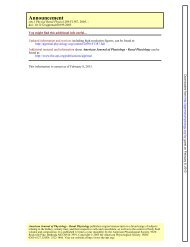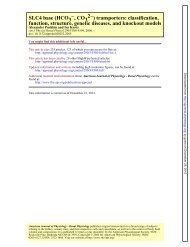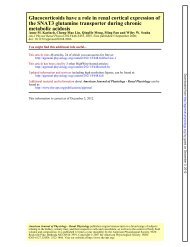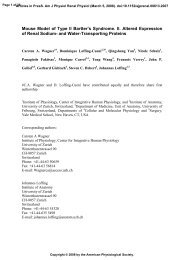Increased susceptibility of aging kidney to ... - Renal Physiology
Increased susceptibility of aging kidney to ... - Renal Physiology
Increased susceptibility of aging kidney to ... - Renal Physiology
Create successful ePaper yourself
Turn your PDF publications into a flip-book with our unique Google optimized e-Paper software.
Fig. 1. Schematic depiction <strong>of</strong> the process used <strong>to</strong> filter and analyze the microarray data.<br />
indicated that age-related changes reflected changes in renal<br />
hemodynamics, rather than differences in the tubular <strong>susceptibility</strong><br />
<strong>to</strong> injury. However, Miura et al. (24) demonstrated that<br />
slices <strong>of</strong> <strong>kidney</strong> from old rats were more susceptible <strong>to</strong> in vitro<br />
anoxia (100% N2) when compared with slices from young<br />
animals as assessed by organic anion transport in the proximal<br />
tubules, indicating that a component <strong>of</strong> the increased sensitivity<br />
<strong>to</strong> injury involves age-dependent alterations in the proximal<br />
tubules.<br />
To investigate the influence <strong>of</strong> age on the response <strong>of</strong> the<br />
<strong>kidney</strong> <strong>to</strong> ischemic injury and <strong>to</strong> provide insight in<strong>to</strong> the<br />
pathways that may underlie the increased <strong>susceptibility</strong> <strong>of</strong><br />
the <strong>aging</strong> <strong>kidney</strong> <strong>to</strong> injury, the objectives <strong>of</strong> this study were <strong>to</strong><br />
1) characterize the increased <strong>susceptibility</strong> <strong>of</strong> the <strong>aging</strong> <strong>kidney</strong><br />
<strong>to</strong> injury, 2) determine whether this response was reversible<br />
using aged caloric-restricted rats, and 3) identify genes<br />
changed by age and corrected by CR. Our results demonstrate<br />
that there is an intrinsic change in the <strong>aging</strong> <strong>kidney</strong> that renders<br />
Table 1. Control slice values<br />
AGING KIDNEY AND ISCHEMIC INJURY<br />
it more susceptible <strong>to</strong> injury and, importantly, this change is<br />
preventable by CR. Using the CodeLink Rat Whole Genome<br />
Bioarray, we identified 92 changes in gene expression that<br />
parallel the functional changes, i.e., altered during <strong>aging</strong> and<br />
attenuated by CR. Several interesting candidates were identified<br />
and verified by quantitative PCR including claudin-7,<br />
<strong>kidney</strong> injury molecule-1 (Kim-1), and matrix metalloproteinase-7<br />
(MMP-7). In summary, several genes were identified that<br />
may be associated with the increased <strong>susceptibility</strong> <strong>of</strong> <strong>aging</strong><br />
<strong>kidney</strong> <strong>to</strong> ischemic insult.<br />
METHODS<br />
Animals. All experimental procedures complied with the Guide for<br />
Care and Use <strong>of</strong> Labora<strong>to</strong>ry Animals and were approved by the Texas<br />
A&M University Labora<strong>to</strong>ry Animal Care Committee. Male Fischer<br />
344 rats [young (4–5 mo), aged-ad libitum (AL; 8, 12, 18, and 24 mo),<br />
aged-CR (24 mo); CR begins at 10 wk, 10% restriction until 15 wk<br />
where it is increased <strong>to</strong> 25 and 40% restriction beginning at 4 mo]<br />
ATP, nmol/mg Tissue GSH, nmol/mg Tissue LDH, U/l/mg Tissue �GST, �g/ml/mg Tissue<br />
30 min 60 min 30 min 60 min 30 min 60 min 60 min<br />
Young 2.11�0.19 1.67�0.18 1.92�0.20 1.89�0.13 1.31�0.16 1.30�0.21 1.20�0.07<br />
Aged-CR 1.90�0.23 1.51�0.21 1.70�0.23 1.67�0.19 1.21�0.11 1.30�0.14 0.97�0.25<br />
Aged-AL 1.86�0.14 1.63�0.09 1.95�0.16 1.89�0.09 1.42�0.25 1.34�0.22 1.10�0.18<br />
Each data point represents means � SD for 4 animals (4 slices per animal). Control slices from each group were evaluated for intracellular ATP and GSH<br />
content as well as leakage <strong>of</strong> LDH and �GST in<strong>to</strong> the culture media as described in METHODS. Aged-CR, aged calorie-restricted rats; aged-AL, aged ad libitum<br />
rats.<br />
AJP-<strong>Renal</strong> Physiol • VOL 293 • OCTOBER 2007 • www.ajprenal.org<br />
F1273<br />
Downloaded from<br />
http://ajprenal.physiology.org/<br />
by guest on December 6, 2012








